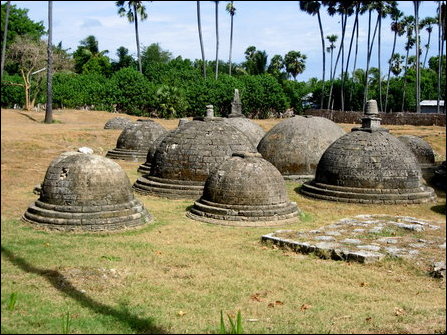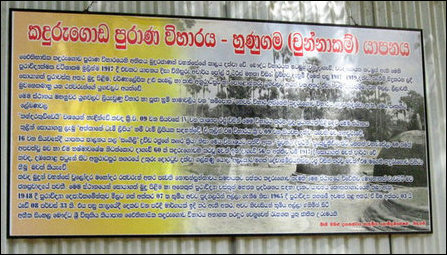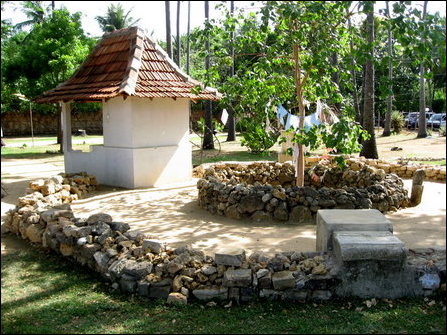
Cultural and psychological attack on Tamils in Jaffna
[TamilNet, Tuesday, 24 August 2010, 22:19 GMT]
A Tamil diaspora visitor who recently went to see the archaeological site at Kantharoadai in the heart of Jaffna peninsula found all signboards in the site in Sinhalicized Sinhala. Further, he was asked to remove shoes to walk the site, indicating that this important heritage site of the people of Jaffna is fast becoming a cult centre of contemporary Sinhala-Budhhism to culturally and psychologically alienate the people of Jaffna from their land. Ancient remains of Buddhism in Tamil land are not a cultural property of today’s genocidal Sinhala-Buddhism. What is happening in Jaffna is perhaps the ‘reconciliation’, meant by the ‘culture and development’ pundits, commented an academic in Jaffna.

The cluster of votive or burial stupas at Kantharoadai. What is seen in the photo is their 1960s reconstructions by the archaeology department, upon the original bases
The Tamil name of the archaeological site is Kantharoadai, meaning the pond of Kanthar.
But the signboards presently displayed in the archaeological site give a Sinhala name Kadurugoda for the site. The description boards in the site are entirely in Sinhala. Besides, the Archaeology Department has also translated the name Chu'n'naakam of the nearby town, from Tamil into Sinhala Hu’nugama, even though the latter was never in usage.

Sinhalicization of the place name of the heritage site of Eezham Tamils
First of all Kadurugoda is a translation of the Tamil name Kathiramalai. In a late historiographical literature of Jaffna, Kathiramalai is mentioned as a seat of an ancient kingdom that existed in the Jaffna Peninsula prior to the medieval Kingdom of Jaffna.
In the early 20th century when the archaeological site at Kantharoadai was brought to light by Paul E Pieris, (grandfather of archaeologist Siran Deraniyagala), it was assumed that Kathiramalai mentioned in the literature should be Kantharoadai. The name Kathiramalai for a locality a couple of kilometres away from the site was cited in evidence. Kadurugoda was then invented either as a translation of Kathiramalai or to rhyme with Kantharoadai.
Kathira-malai means ‘the mound of acacia’ (Udai-mu'l'lu or Karuveala-mu'l'lu).
Kathiram in Tamil, and Khadira in Sinhala stand for the spiky acacia shrub. The plant got the name because of its prominent spikes or thorns. The Tamil word Kathir means spike (Dravidian Etymological Dictionary 1194, 1195). This word has Kannada and Telugu cognates spelt as Kaduru.
Even though Kaduru in Sinhala is a generic name for some species of trees bearing poisonous nuts, what suits the natural vegetation of the locality is acacia.
Koadu (a synonym of Malai) in Tamil / Malayalam means hill, hillock, peak, summit of a hill etc., as well as bank of a stream or pond (Dravidian Etymological Dictionary 2049, 2200). Goda in Sinhala means heap, mass, mound etc as well as land at a water’s edge. Both the Tamil / Malayalam koadu and the Sinhala goda are popular place name suffixes. Thousands of place names in the Sinhala heartland of the island end with goda and in this sense the word also stands for a village or hamlet.
Obviously, even after rendering Kathiramalai into Sinhala as Kadurugoda, there is nothing non-Dravidian in it.
But we have some Sinhala academics not knowing their Sinhala, telling that Eezham Tamils are ‘language-replaced’ Sinhalese. They cite the Eezham Tamil place names as examples. Given the nature of the admixture of Dravidian and Prakrit in the island in evolving Eezham Tamil and Sinhala languages, the Tamils can also say that the Sinhalese are ‘language-replaced’ Tamils.
Amusingly, the same academics also imagine the presence of Sinhala-Buddhism wherever they find a Bo tree in the Tamil land.
The cluster of Buddhist stupas found at Kantaroadai is a heritage of the people of Jaffna. Buddhism was not the beginning of heritage in Jaffna. Below the Buddhist layer of Kantharoadai, evidences for an earlier culture called the megalithic culture of South India was noticed by Pennsylvania University archaeologists in the 1960s.
According to Pali chronicles, when the first Buddhist emissaries in the 3rd century BCE came to the island through Jaffna peninsula, the name of the port in its Pali rendering was Ko’la Patuna (Kozhu-paddinam, meaning the port at the point). The name clearly indicates that it was a Tamil port town, as both Kozhu and Paddinam are Tamil / Dravidian terms (DED 2147, 3868).
The Tamil Buddhist epic Ma’nimeakalai testifies to Buddhism prevailing among Tamils in the island in the early centuries of the Common Era. It was a cultural choice of Eezham Tamils that they relinquished Buddhism later. But the archaeological remains are their heritage.
This heritage doesn’t give licence to today’s Sinhala-Buddhists to alienate Tamils from their land or to justify cultural genocide.
Sinhala academics reacting to what Jeremy Page wrote on Army and Archaeology phenomenon in the island miss the point or intentionally ignore it.
The cultural and psychological assault that is taking place in the Tamil land may be unimportant to the development conquistadors, but these were some of the very fundamentals that brought in the conflict in the island and they are unleashed more than ever today. The chronic situation will aggravate without territorial power status quo of the ancient nations in the island.

Description boards are entirely in Sinhala in the heritage site of the people of Jaffna. The board notes the name of the site as Kadurugoda and the adjacent town as Hu'nugama in Yaapanaya

A modern shrine for worship built in the archaeological site
07.05.10
Naaka-naadu
Naaka-theevu
Naaga-deepa
Chronology:










